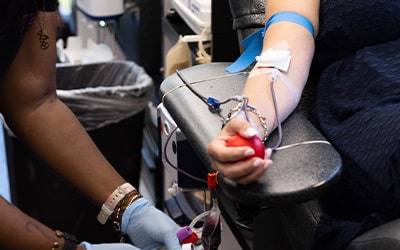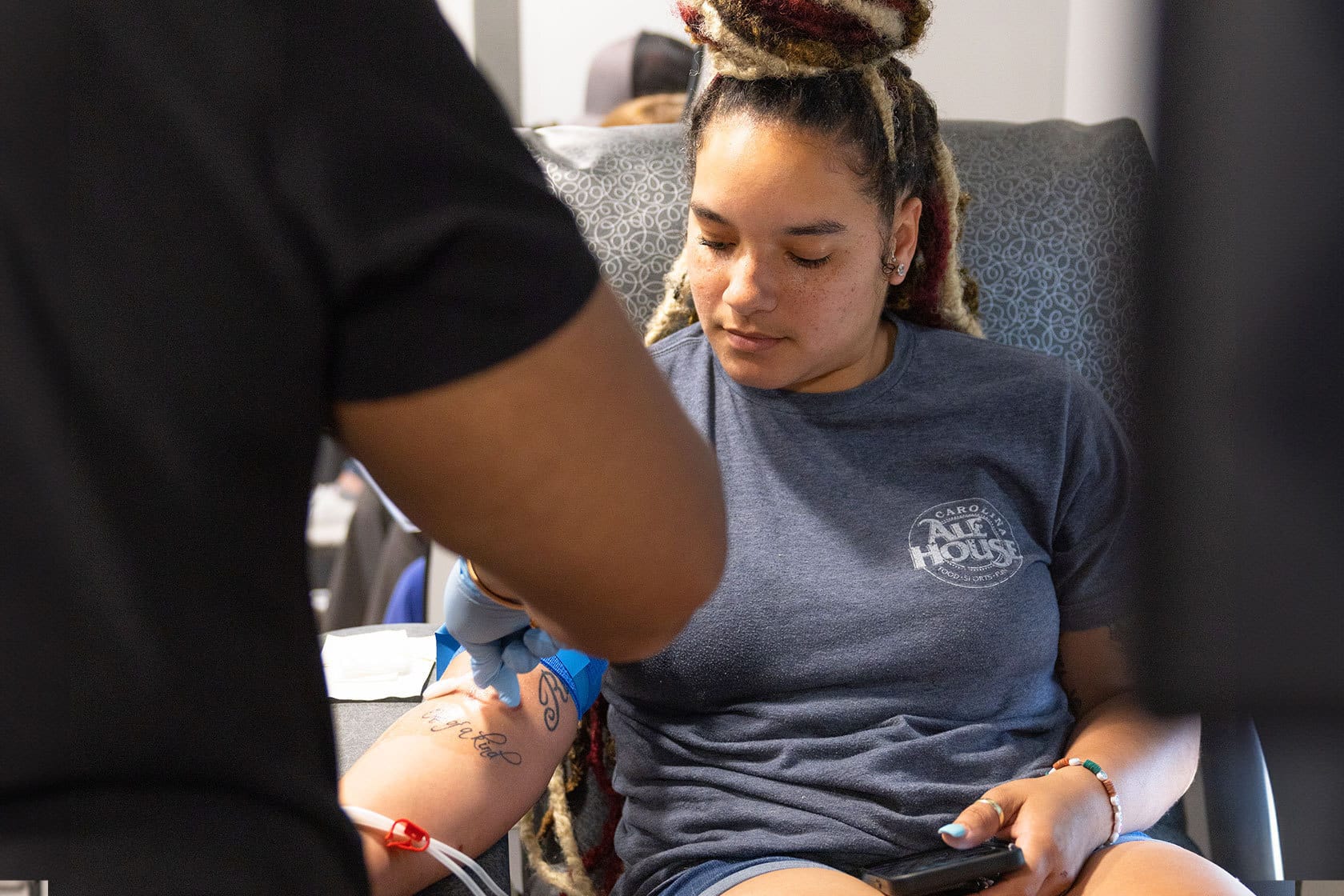
First-Time Donor? Don’t Let Fear (or Misinformation) Hold You Back

First-Time Donor? Don’t Let Fear (or Misinformation) Hold You Back
Donating blood for the first time can feel overwhelming, but it doesn’t have to. At The Blood Connection, we work hard to ensure new and regular donors stay informed and comfortable throughout the donation process.
Why Are Blood Donations So Important?
Blood donations are a life-saving gift. The generosity of donors helps countless individuals across the country recover from illness or injury and enjoy a quality of life they might not otherwise. There’s a constant need for blood in the U.S., with someone needing a blood transfusion every two seconds. This adds up to approximately 30,000 units of blood each day, meaning it takes 10,000 daily donations to meet the demand.
Unfortunately, only 38% of the U.S. population is eligible to donate, and of those who are eligible, only 3% actually donate. These numbers show the vital need for more donors. Without sufficient donations, there will be more frequent shortages in the national blood supply, and people in critical situations won’t get the life-saving transfusions they need.
Blood transfusions help treat an array of conditions, both planned and unplanned. Cancer, blood disorders, and other chronic illnesses often call for regular transfusions of blood products. Emergency operations and complications during childbirth can also cause sudden surges in demand that exceed the blood reserves of many medical facilities. So, not only does there need to be a regular supply for ongoing treatments, but there also needs to be enough blood products available to meet unexpected demands. If you’re considering donating for the first time, there’s never been a better time to start.
Overcoming Donation Fears
Donating can be intimidating if you’re not well-informed about the process. Let’s address some common fears of first-time donors and see how The Blood Connection sets people at ease by making the donation process as smooth as possible.
1). Fear of fainting
Fainting is a common fear of many donors, but it happens far less than many people think. And, even more encouraging, it’s relatively easy to avoid. To prevent feeling light-headed or fainting, eat a healthy meal and drink an extra 16 ounces of water before you arrive at your donation center.
2). Fear of needles
We get it — needles can be scary. To ease your nerves, feel free to bring someone to calm and distract you as you donate. And if you’re feeling nervous, just let us know. Our team is happy to work with you to ensure you’re calm and comfortable. For most first-timers, we recommend simply looking away during the initial setup process. Of course, if you’re the curious type and want to know what’s happening, feel free to watch. It’s entirely up to you.
3). Fear of low iron levels
If you’ve struggled with low iron in the past, don’t let that deter you from donating blood. Just because you’ve been turned away because of low iron levels before doesn’t mean you can’t ever give blood. You’ll complete a mini-physical at our donation centers before every donation to ensure your iron levels are safe to donate. And if you are struggling with low iron, our team is happy to recommend ways to increase your iron levels.
4). Fear of being sick after donating
If you’ve never donated, you might worry about how you’ll feel when you finish. After each donation, you’ll be given refreshments to replenish the liquids and sugars in your blood. You’ll also be asked to “take your 10,” which is a short period of time during which our team will ensure you are well enough to leave. And if you start feeling unwell, our team is ready and able to help.
5). Fear of not having enough time
Some people worry that donating will knock them out for the entire day. The donation process should only take an hour, with the actual donation taking approximately 10 minutes. As long as you are well-prepared before your donation and rehydrate and eat immediately afterward, you should be ready for the rest of your day in no time.
Debunking Common Donation Myths
Donation myths are one of the biggest reasons people choose not to donate blood. We think it’s important for our donors to know the truth about donating so they can make an informed decision about whether or not to donate. That’s why we’re happy to dispel some of the most common misconceptions about giving blood.
Myth #1: It takes a long time to donate.
Fact: The entire donation process only takes about an hour from start to finish, and the actual donation only takes about 10 minutes.
Myth #2: Donating blood hurts.
Fact: The slight discomfort you’ll feel when donating is a quick pinch from the needle as it goes into your arm. After that, you shouldn’t feel any discomfort.
Myth #3: Your donation is unnecessary unless you have a rare blood type.
Fact: Every blood type is vital to maintaining a diverse national blood supply. Believe it or not, common blood types have a higher demand since more people can use them. Rare blood types have a smaller pool of donors, so the available supply is usually lower. Long story short, your donation is needed no matter your blood type.
Myth #4: Donating will deplete your blood supply.
Fact: It takes 24 hours for your body to replenish your plasma and 4-6 weeks to replenish your red blood cells. That’s why you can donate every 56 days. Rest assured, donating a pint of blood still leaves plenty for your body to operate at full capacity.
Myth #5: You can be too old to donate.
Fact: There is no maximum age to donate, but there is a minimum. Blood donors must be 16 or older, and parental permission is required for donors under 18.
Myth #6: You can’t donate if you have tattoos or piercings.
Fact: In most states, you can donate blood immediately after getting a tattoo or piercing as long as you get it from a state-regulated parlor. Tattoos not applied by a licensed technician using a sterile needle and non-reused ink and piercings not done using single-use equipment will defer your eligibility for six months.
Myth #7: You can’t donate if you’re on medication.
Fact: In most cases, your medication won’t disqualify you as a donor. It’s more common to be disqualified due to the condition that warranted the medication rather than the medication itself. If you’re unsure whether your medication affects your ability to donate, please ask one of our team members at your donation center.
Myth #8: It’s dangerous to donate if you have high blood pressure.
Fact: If you’re worried about your blood pressure, you can rest easy knowing that we take your blood pressure during the mini-physical before your donation. You’ll be cleared to donate if the first number (systolic pressure) is below 180 and the second (diastolic pressure) is below 100. Even if you’re on blood pressure medication, you can still qualify. You can contact The Blood Connection to confirm that your medication is not on the deferral list.
One Donation Makes a Lasting Impact
Your blood is composed of blood cells, platelets, and plasma, all of which can help different patients. Red blood cells are commonly used during surgery, platelets can be used to treat cancer, and plasma is used for trauma and burn victims. Each type of blood product serves a vital purpose — and a single donation can save up to three lives!
Before you donate, check to see if you meet our Donor Eligibility Requirements. If you’re eligible, you can start giving blood today. At The Blood Connection, you can schedule an appointment online or simply walk into a donation center. And remember — your generosity is changing and saving lives!








